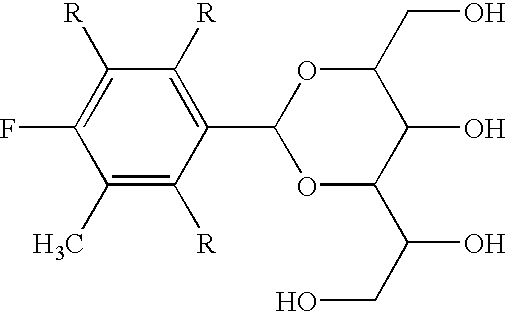Method of producing high yield alditol acetals with mineral acids and surfactants
a technology of alditol acetals and mineral acids, applied in the direction of organic chemistry, etc., can solve the problems of high cost of solvents, limited implementation of reaction procedures within different dbs compound producing methods, and inability to meet the requirements of high-quality alditol acetals, etc., to achieve high yield, high versatility, and high efficiency
- Summary
- Abstract
- Description
- Claims
- Application Information
AI Technical Summary
Benefits of technology
Problems solved by technology
Method used
Image
Examples
example 1
Preparation of 3,4-Dimethyldibenzylidene Sorbitol With Cationic Surfactant
A one-liter polyethylene beaker equipped with a mechanical stirrer was charged with D-sorbitol (52 g, 0.285 m), 140 g of aqueous sulfuric acid (50% concentrated), 2.0 g of trimethylhexadecyl ammonium chloride, 50% active (0.00313 m), and 53.6 g (0.40 moles) of 3,4-dimethylbenzaldehyde. The mixture was stirred for 16 hours (with stopping due to the formation of an unstirrable powder) and 22 hours of reaction without stirring. A solution of cold water (200 mL) and NaOH (80 g) was then added to neutralize the acidic formulation.
The resultant solids were then filtered, washed in water, and collected for analysis. The resultant mixture was measured as 61 g of 1,3:2,4-bis(3,4-dimethylbenzylidene)sorbitol, for a yield of 73.7% and a purity of about 98.8% (with a small amount of the triacetal formed and some traces of the benzaldehyde remaining).
example 2
Preparation of 3,4-Dimethyldibenzylidene Sorbitol With Nonionic Phenol Surfactant
A one-liter polyethylene beaker equipped with a mechanical stirrer was charged with D-sorbitol (52 g, 0.285 m), 140 g of aqueous sulfuric acid (50% concentrated), 1.0 g of octyl phenol (9.5 mole of ethoxylate) (0.00155 m), and 53.6 g (0.40 moles) of 3,4-dimethylbenzaldehyde. A solution of cold water (200 mL) and NaOH (80 g) was then added after 22 hours of further stirring. The resultant solids were then filtered, washed in water, and collected for analysis. The resultant mixture was measured as 59.2 g of 1,3:2,4-bis(3,4-dimethylbenzaldehyde) sorbitol, for a yield of 71.5% and a purity of about 97.1% (with a small amount of the triacetal formed and some traces of the benzaldehyde remaining).
example 3
Preparation of 3,4-Dimethyldibenzylidene Sorbitol With Amine Surfactant
A one-liter polyethylene beaker equipped with a mechanical stirrer was charged with D-sorbitol (52 g, 0.285 m), 2.0 g of dimethyl dodecylamine (0.0094 m), and 53.6 g (0.40 moles) of 3,4-dimethylbenzaldehyde. Aqueous acid was then prepared by mixing 93.3 g of concentrated HCl and 48 g of water. A 5 mL aliquot of the aqueous acid was then added to the reaction mixture which created an emulsion after 5 minutes. The remaining amount was then introduced and the resultant mixture became solid in about 5 hours. Another addition of aqueous acid was then followed (93.3 g HCl and 63.6 g of water) and the resultant mixture was stirred for another 17.5 hours. A solution of cold water (200 mL) and NaOH (80 g) was then added to neutralize the product to a pH of about 9. The resultant solids were then filtered, washed in water, and collected for analysis. The resultant mixture was measured as 58.8 g of 1,3:2,4-bis(3,4-dimethylb...
PUM
| Property | Measurement | Unit |
|---|---|---|
| time | aaaaa | aaaaa |
| melting point | aaaaa | aaaaa |
| melting point apparatus | aaaaa | aaaaa |
Abstract
Description
Claims
Application Information
 Login to View More
Login to View More - R&D
- Intellectual Property
- Life Sciences
- Materials
- Tech Scout
- Unparalleled Data Quality
- Higher Quality Content
- 60% Fewer Hallucinations
Browse by: Latest US Patents, China's latest patents, Technical Efficacy Thesaurus, Application Domain, Technology Topic, Popular Technical Reports.
© 2025 PatSnap. All rights reserved.Legal|Privacy policy|Modern Slavery Act Transparency Statement|Sitemap|About US| Contact US: help@patsnap.com

